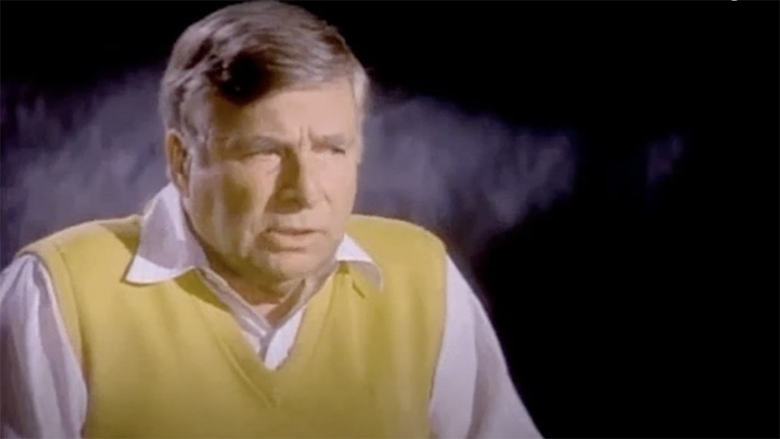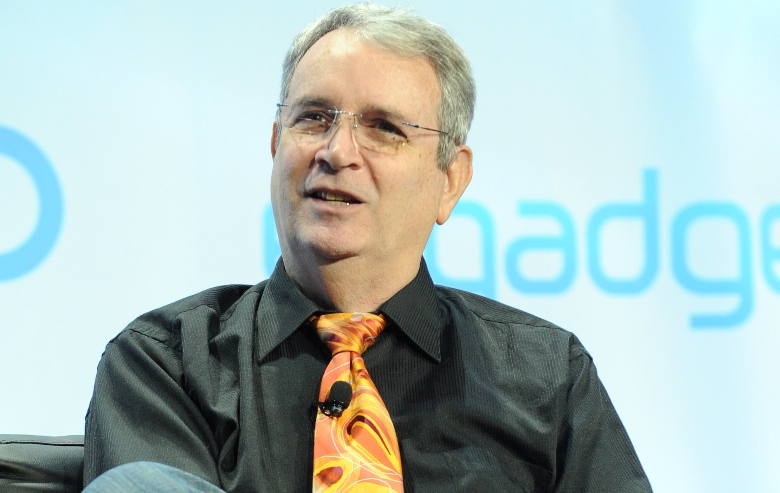
YouTube Intro sequence for “Star Trek: The Next Generation”
Though “Star Trek” fans may not recognize the name David Gerrold, they definitely recognize his contributions to the Trekverse. Gerrold wrote one of the most popular episodes of “Star Trek: The Original Series” — “The Trouble With Tribbles.” He also created the TOS episode “The Cloud Minders” and wrote the “Star Trek: The Animated Series” episodes “More Tribbles, More Troubles” and “Bem.”
When work began on “Star Trek: The Next Generation,” Gerrold was personally invited to write for the series by Gene Roddenberry, “Star Trek’s” creator. He came on board excited to work on a new “Star Trek” universe.
Gerrold was also excited because he’d been told that since the show was going straight to syndication, the creative team wouldn’t have a network constantly looking over their shoulders. They would have the freedom to do things that they hadn’t been able to do on “The Original Series.”
When Gerrold submitted his script “Blood and Fire,” an allegory for the AIDS epidemic that featured two gay crewmen, the script was vehemently rejected. In the process, he discovered that he would not have the freedom to address serious social issues on TNG.
In an exclusive interview with Heavy this week, Gerrold told his whole story about the “Blood and Fire” script and what it taught him about working for “Star Trek.”
The Promises of a New ‘Star Trek’

YouTube“Star Trek” creator Gene Roddenberry.
Before production on the series even started, Gerrold accompanied Roddenberry to a “Star Trek” convention in Boston. The convention took place soon after “The Next Generation” was publicly announced. So, according to Gerrold, the attendance was much higher than a typical convention.
During a question-and-answer session attended by more than 3,000 people, a gay fan frankly asked Roddenberry if there would be gay crew members in the new show. According to Gerrold, Gene answered, “Yes, it’s time.”
Gerrold said he immediately made note of Roddenberry’s answer because he was actively working with one of the other writers, Robert Justman, to come up with ideas for the new show. He wanted to be sure that he told Justman they could include a gay character.
Gerrold told Heavy that the topic came up again during one of the early TNG staff meetings. He said that Roddenberry was clear that he wanted to include a gay character on the show. When one of the writers made a derogatory joke about a gay crewman, Gerrold said Roddenberry read him the riot act. He reiterated that “it was time” to introduce a gay crew member in the “Star Trek” universe.
Gerrold emphasized that the timing was very important. It was the late 80s, at the height of the AIDS epidemic. The crew of “Star Trek” had even lost a colleague to AIDS. Including a gay character in a television show, even a syndicated one, was a bold move. However, Gerrold insisted it was a move Roddenberry was ready to make.
According to Gerrold, shortly after that, Paramount assigned Rick Berman to work on the show. Gerrold claimed that the studio sent Berman to TNG essentially to babysit Roddenberry and that Roddenberry was not pleased about the decision.
Gerrold said that shortly after Berman arrived, he wrote a memo about the topics that the studio was okay with covering in “Star Trek” episodes. Among those approved topics was the AIDS epidemic. Gerrold said he took note of that immediately because he wanted to write something about the topic.
So, Gerrold went into his first script assignment with the understanding that Roddenberry himself wanted to include a gay crew member and that the studio approved of an episode about the AIDS crisis.
Writing For a Cause

Craig Barritt/Getty ImagesDavid Gerrold speaks onstage at Engadget Expand NY 2013 at Jacob K. Javits Convention Center on November 10, 2013 in New York City
Gerrold decided that he wanted to write a script about blood donation. A good friend of his, the famous science fiction writer Robert A. Heinlein, underwent major surgery, which required multiple blood transfusions. After that, Heinlein became a vocal advocate for blood donation, as did Gerrold.
He decided that he wanted to honor Heinlein by doing an episode of “Star Trek” about blood donation.
“I came up with this idea about a disease so bad that you’re supposed to destroy the ship and not attempt to rescue. So right there you have tension for the crew. And it turns out the only way we can save them is blood tranfusions. And then it turns out that we don’t have enough artificial blood so we have to have people donate blood. And I wanted to put a card at the end of the episode ‘you too can donate blood.’ Because of the AIDS crisis we were having a critical shortage of blood donors. People were afraid to donate blood, and I wanted to address that. That was the goal of that. And I thought, this is a totally perfect ‘Star Trek’ story, a totally perfect ‘Star Trek’ goal. And it would demonstrate the power of ‘Star Trek’ because… if the episode were broadcast on a Thursday night and on Friday a million people donated blood that would demonstrate the power of ‘Star Trek.’ And it would do enormous good all over the nation, maybe all over the world.”
With that goal in mind, Gerrold started work on “Blood and Fire.”
The ‘Blood and Fire’ Controversy
Gerrold told Heavy that the outline for his “Blood and Fire” episode was approved without issue. When he started working on the script, he realized that he could easily include two gay characters. He didn’t plan on putting gay crew members in the script, but he realized the episode would be a great opportunity to follow through on Roddenberry’s promise of queer inclusion.
So, he wrote a very simple scene that featured a gay couple. In the scene, two crewmen were working with Commander William Riker, who asked one of them, “How long have you two been together?” The crewman replied, “Since the Academy.”
Gerrold emphasized, “And that’s it. Now if you’re under 12, they’re friends… and if you’re over 12 you get it. They’re boyfriends. And that was it.”
He submitted the script on a Thursday and left for a Star Trek cruise the next day. While he was on the cruise, he got a note from Roddenberry saying that everyone loved his script and that he should have a good time on the cruise.
However, when he returned Gerrold found out that everyone did not, in fact, love his script. As soon as he walked into his office, he saw a note from fellow Trek veteran writer Dorothy Fontana. The note warned him not to speak to anyone on staff until he’d talked to her. When Gerrold found her, she gave him the rundown. Half the staff hated his script and half the staff loved it. They were deadlocked about moving forward.
Gerrold said that one of the lead writers was very concerned about the gay characters and that Berman had written a whole memo about how they couldn’t move forward with the episode. According to Gerrold, Berman’s argument was that “mommies will write letters.” Gerrold said that Berman emphasized that the show would be on during family hours on some networks and the content of the episode was not family-friendly.
Gerrold told Heavy that he was livid about the reaction to the script. He insisted that the writers had been promised that TNG would “do issues shows.”
“Gene had been telling people ‘What’s that story you want to tell that sticks in your craw, that nobody else is going to let you tell?’ And this was the one! You know, I got excited. This was the chance. Nobody else on television was even addressing gay characters at the time… If you saw a gay character on TV usually it was to make fun of them. There were only two ways you saw gay people on movies or TV, that they were going to commit suicide… or they were an object of ridicule… and I wanted to change that conversation. I thought ‘Star Trek’ is the perfect place to do it… Gay people were saying ‘We’re not invisible. Please include us too.’ And so I was appalled at the fact that we had Rick Berman and a couple of other [people] writing these memos.”
Gerrold decided to respond with his own memo. He emphasized that Roddenberry had promised the fans a gay character and insisted that now was the time to fulfill that promise. He also reminded the staff that “Star Trek” was supposed to be “an issues show” tackling the tough topics. Additionally, Gerrold pointed out that “if mommies write letters… it shows they’re watching the show.”
Gerrold said that one of the producers told him the memo was wonderful. Then he promptly informed him that he still had to take the gay characters out of the script. Reluctantly, Gerrold agreed.
The rewrite got assigned to another writer, even though Gerrold offered to do it. Gerrold claimed that Roddenberry asked the writer to lie to him and say that he wasn’t okay with Gerrold doing the rewrite. The writer told him the truth instead. That lie was the beginning of the end of Gerrold and Roddenberry’s professional relationship and their friendship.
After much controversy, Gerrold said the script was permanently shelved. He blamed this mostly on Berman and Roddenberry’s lawyer Leonard Maizlish. Gerrold also claimed Maizlish was largely behind the toxic work environment that forced him to leave the show.
Though he started working on TNG with much excitement, Gerrold left before the show even aired. He didn’t even want a producer credit because he was so upset with how the first season was turning out.
‘Blood and Fire’ Lives On
Though “Blood and Fire” never became a canon episode of “Star Trek,” it lived on in a few different ways.
After Gerrold left TNG, he still regularly attended Star Trek conventions. During those conventions, he started selling autographed copies of the rejected “Blood and Fire” script directly to fans. He donated half of the profits to the AIDS Project of Los Angeles. Gerrold continued to sell the scripts at conventions for years. He donated about $30,000 to the AIDS Project of Los Angeles during the years he was selling the scripts.
Since he left writing for television, Gerrold has been a novelist. In the early 2000s, he decided to write a novelization of his infamous “Blood and Fire” script. The book became the final chapter of his Star Wolf series.
A few years later, James Cawley, the producer of the “Star Trek” fan series “Star Trek New Voyages: Phase II,” contacted Gerrold and said that he wanted to make “Blood and Fire.” Though the episode was originally written by another “Star Trek” fan, Cawley asked Gerrold to do a rewrite. They ended up having some amazing conversations about what they wished “Star Trek” had been, and the two decided to make the “Star Trek” they wanted to see. Gerrold decided to rewrite the script entirely.
While he was working on the rewrite, Cawley asked him to expand on the gay characters to make them a significant part of the episode. One of the gay characters became Kirk’s nephew. During the episode, he came out to Kirk by asking him to perform his wedding ceremony.
The single episode became two episodes, which basically turned into a feature film. Gerrold decided to direct the episodes as well, which can be viewed in the video above.
Gerrold told Heavy that the fan series allowed him to make the kind of “Star Trek” he’d always wanted to make. It gave him the opportunity to do what he’d never been allowed to do when he was actually writing for “Star Trek.”
These days, Gerrold is still steadily cranking out science fiction novels and he’s preparing to work on his memoir. Though he wishes things had worked out with “Star Trek,” Gerrold admitted that leaving the industry was the best decision he ever made.
Follow the Heavy on Star Trek Facebook page for the latest breaking news, rumors and content!







